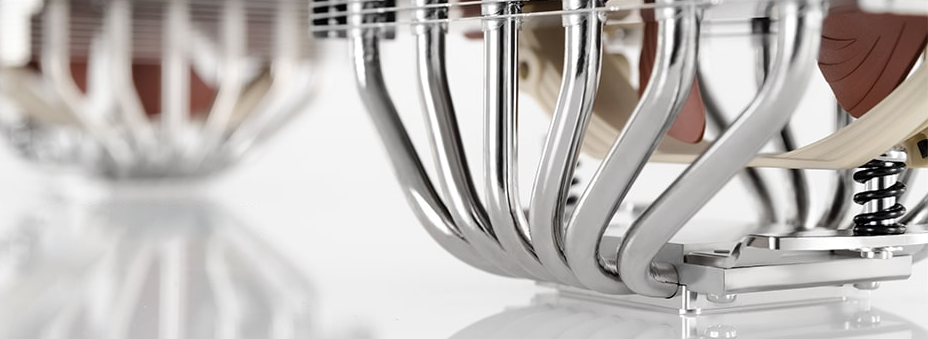[ad_1]
//php echo do_shortcode(‘[responsivevoice_button voice=”US English Male” buttontext=”Listen to Post”]’) ?>
Heat pipes are widely used in various cooling systems that cool down everything from notebooks to electric vehicles—and from industrial equipment to space telescopes. Because heat pipes are so pervasive and serve so many applications, there are plenty of their types and researchers are constantly studying ways to improve their efficiency and/or make them more suitable for new applications. To do so, they need to precisely study how liquids and liquid mixtures behave in heat pipes.


A group of researchers from Rensselaer Polytechnic Institute is investigating the performance of wickless heat pipes filed with a mixture of pentane and isohexane fluid on board the International Space Station (ISS), as well as on Earth. The researchers have already tested the behavior of pentane/isohexane mixtures on ISS in 2016, as well as studied wickless heat pipes on Earth. New experiments will be conducted to study various factors affecting heat transfer, including the effects of Marangoni forces, condensation, and the presence of Leidenfrost droplets. The project will also explore how gravity influences these factors.
“The main goals of the current study are to understand the interfacial phenomena of liquid mixtures when phase change processes (evaporation and condensation) occur,” said Professor Joel Plawsky, the head of Isermann Department of Chemical and Biological Engineering at Rensselaer and the leader of the research project. “The mixture we are using may not be optimal for enhancing heat pipe performance but what we observe would be of use in many other processes, such as understanding distillation and how fluid mixtures affect evaporator performance and condenser performance. For example, new refrigerants are mixtures of liquids, not pure components. Understanding how they behave allows us to design more efficient cooling systems.”


Pervasive heat pipes
Heat pipes are simple yet very efficient heat transfer mechanisms. A heat pipe is usually a sealed copper tube that contains a certain amount of a functional liquid like water. When exposed to a heat source, also known as the evaporator, this liquid turns into vapor as it heats up. This vapor then moves through the heat pipe to a section called the condenser, where it turns back into liquid and gives off stored heat. Finally, the liquid flows back to the evaporator, completing the cycle without requiring any mechanical components. Water is rarely used as functional liquid since its evaporation point is rather high (100°C) and coolants with a lower evaporation point (40°C – 50°C) are preferrable. In addition to factors like the evaporation point of coolant, there are aspects like Marangoni forces and Leidenfrost droplets that affect the performance of heat pipes.


Marangoni forces can influence the movement of the coolant within the heat pipe, affecting how efficiently heat is transferred from the evaporator to the condenser and therefore enhance or hinder the phase change process. Meanwhile, Marangoni forces often interact with other forces like capillary forces (which is important for wicked heat pipes) and the balance between these forces can determine the heat pipe’s performance and any limitations it may have. Understanding Marangoni forces is particularly important in specialized applications like microgravity environments, where traditional gravity-driven flow is minimal. In such cases, Marangoni forces can play a dominant role in the heat pipe’s operation.
Leidenfrost droplets are drops of the coolant that hover over the hot surface of the evaporator due to rapid vaporization at the point of contact (they vaporize when they encounter a surface much hotter than its boiling point). This vapor cushion acts as an insulator, reducing heat transfer efficiency. The presence of these droplets can also lead to stability issues in the heat pipe’s operation. Understanding the Leidenfrost effect is crucial for high-temperature applications where it is more likely to occur.
Most heat pipes used in cooling systems for PCs are porous, but the researchers use wickless heat pipes instead. Wickless heat pipes offer some distinct advantages, including simpler design and potentially lower manufacturing costs. They are particularly well-suited for environments where gravity’s effects are minimal, such as in space applications, because they rely on the fluid’s own properties and external forces for operation. Additionally, the absence of a wick means there is less flow resistance, which can sometimes result in better thermal performance.
“The main advantages are that wickless heat pipes can be lighter in weight, wicks can clog, degrade, or be choked off by vapor formation in the pores, and if a system happens to freeze, a wickless system can theoretically transport a slurry during start-up that would clog a wick,” Plawsky said. “[For us], the only real advantage of wickless heat pipe is that we can see inside it and tell where the liquid and vapor are, which allows us to test ideas about how heat pipes work.”
In general, wickless heat pipes also have their limitations, which is why they are not used for widely available commercial applications. Wickless heat pipes are generally less versatile than wicked heat pipes, especially when it comes to orientation and working against gravity, which makes them less suitable for applications where the device needs to function in varying positions (i.e., the majority of applications on Earth). Furthermore, they may not be as effective at handling high heat change compared to their wicked counterparts, limiting their use in high-performance applications like PCs.
New mixtures as coolants
Recent findings indicate that using a blend of fluids, rather than a pure fluid, could enhance the efficiency and reliability of heat pipes, in particular, and phase change cooling systems (e.g., vapor chambers, cold plates, etc.), in general. To create the best possible coolant mixture, one has to understand precisely how the contents interact with each other and how the mixture behaves in a particular heat pipe (i.e., interact with its surface).
Since the point of the research is to understand the effects of Marangoni forces, Leidenfrost droplets, and condensation peculiarities in wickless heat pipes in various environments, the researchers use pentane/isohexane fluid mixtures.
“We originally studied pure pentane and showed that Marangoni forces played a large role,” Plawsky said. “We use the mixture as a form of self-rewetting fluid to improve the system performance. Self-rewetting fluids use concentration gradients to offset temperature gradients. A kind of push me-pull you suite of Marangoni forces that conceal each other out. We used pentane and isohexane because they are very simple fluids and we can accurately calculate how they interact with surfaces.”
These mixtures have very high evaporation points of nearly 250˚C and they will hardly ever be used for commercial applications. Meanwhile, pentane/isohexane fluid mixtures are considered ideal for studying heat pipes.
“We got our pentane and isohexane mixtures to temperatures of nearly 250˚C,” Plawsky said. “We will do the same now. The temperature limit is defined by the flash point of the most volatile substance, pentane. This is a safety issue, not a scientific one.”
While the mixture will hardly ever be used for cooling systems as it is flammable, it is particularly good for scientists who want to study the behavior of fluids in convoluted pipes.
“Pentane and isohexane are model fluids, not fluids that are ideal for commercial applications,” Plawsky acknowledged. “Most people want to work with water or in the microelectronics field, or other refrigerants whose big advantage is that they are non-flammable. [But usage of the pentane/isohexane mixture will provide] fundamental knowledge and the ability to use very pure fluids in complicated geometries.”


The study will employ a constrained vapor bubble (CVB) setup (which scientists from Rensselaer Polytechnic Institute and NASA have been using for some time) located on the ISS and on Earth to explore how different surface interactions behave in organic fluid combinations.
“Our system vaporizes liquid at the hot end, condenses that liquid at the cold end, and returns that liquid via the shape corners of the cuvette that contains the fluid,” Plawsky said. “We use a microscope to visualize naturally occurring interference fringes that result from reflections at the glass-liquid and liquid-vapor interfaces.”


New way of measurements
One of the interesting things about the research is that it will use a technique called multi-wavelength interferometry to examine the interaction between the vapor and liquid states in the heat pipe. This method can spot curvature changes that guide fluid flow and can also pinpoint localized phase shifts within the liquid arches in the system.
“Multiple wavelength interferometry can enhance the resolution of our measurements and the higher the frequency of the light, the thinner the films we can measure,” Plawsky said. “So, blue light deals with thinner films than red light.”
The researchers plan to focus on areas near the heat source, where Marangoni and capillary forces could create new performance bottlenecks, and where molecular forces seem to trigger unexpected liquid formation. This boundary study will be paired with temperature data to better understand and predict the heat pipe’s heat management. Then, computational models will be developed to interpret these findings, covering both the arch areas and the overall device.


The scientists hope that the project’s findings will help improve the design of phase-change-based cooling systems that are widely used in various areas, including PCs. The research will also define the limits of evaporation and condensation, liquid curve stability, and the validity of ideal fluid blend theories in phase equilibrium thermodynamics. When combined with previous studies, it might help to identify the most effective mixture ratio for optimizing heat transfer and cooling efficiency.
“We are hoping to understand how liquid mixtures behave in microgravity when heated,” Plawsky explained. “The CVB, when filled with a liquid mixture, will behave not only as a heat pipe, but as an evaporative distillation device with high boiling point liquid concentrated at the heater end and the lower boiling point liquid at the condenser end.
“We are not sure how the concentration and temperature changes will interact and affect the liquid and vapor flow in the device, so that is something we are trying to understand by actually seeing where the liquid and vapor go in the system. Though we are only studying one mixture composition here, when combined with past work we will get an idea of what the best mixture ratio may be for enhanced heat transfer and cooling performance.”
[ad_2]
Source link

